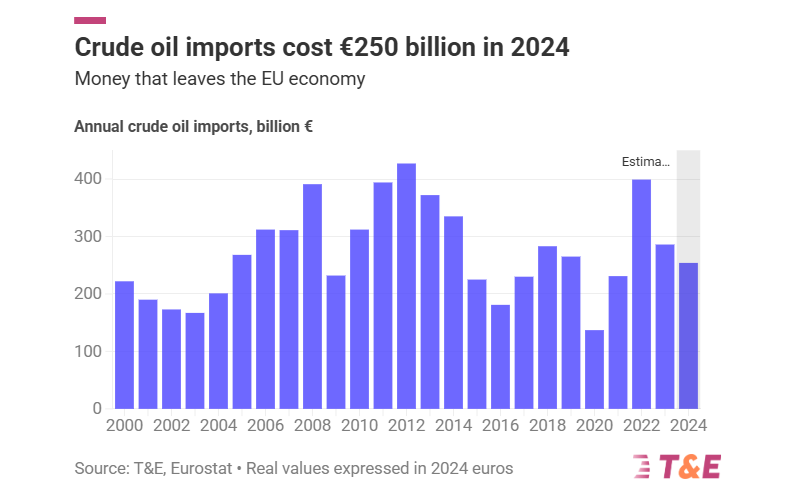The latest State of European Transport report reveals a decline in transport emissions across Europe, driven by the increasing adoption of electric vehicles (EVs). However, rising emissions from air travel are offsetting the carbon savings achieved on the road, according to an analysis by Transport & Environment (T&E).
T&E projects that the surge in electric vehicles will result in a 20 million-tonne reduction in CO₂ emissions in 2024, equivalent to the output of seven coal power plants. Yet, this progress is being undermined by the aviation sector, which saw a 10% rise in emissions in 2023, and persistently high emissions from the shipping industry.
Transport emissions see structural decline
According to the report, Europe’s transport sector emitted 1.05 billion tonnes of CO₂ in 2024, down 5% from 2019 levels. This drop is largely attributed to the rapid growth of EVs, with nearly 9 million battery electric vehicles expected on European roads by the end of the year.
T&E’s Executive Director, William Todts, emphasised the importance of maintaining momentum in green policies: “The EU’s green policies are beginning to bite. Thanks to the switch to EVs, we are starting to see a structural decline in transport emissions. Europe is slowly releasing itself from its dependence on oil, but we are still spending hundreds of billions on imports from overseas powers. Now is not the time to roll back green measures. For the continent’s prosperity and security, now is the time to double down.”
Despite these advances, Europe remains heavily reliant on energy imports, with 96% of its crude oil and 90% of its natural gas sourced from overseas. In contrast, materials for EV batteries—such as lithium, nickel, and aluminium—can be recycled, offering greater long-term sustainability. T&E’s analysis shows that by 2030, an EV will consume just 20 litres of materials for its battery over its lifetime, compared to 12,400 litres of fuel for a combustion engine car.
Aviation and shipping continue to drive carbon emissions
While road emissions are set to decline, aviation and shipping remain significant sources of pollution. European airlines emitted 143 million tonnes of CO₂ in 2023, up nearly 10% from the previous year, while emissions from shipping remained high at 195 million tonnes of CO₂ equivalent.
However, the inclusion of shipping in the EU Emissions Trading System (ETS) is expected to generate €5 billion in revenues in 2024, a figure that could rise to €30 billion annually by 2030, according to T&E. These funds, the group argues, could help close the price gap between green e-fuels and fossil fuels, accelerating the transition to sustainable alternatives.
Future policy direction
The findings come amid debates over the future of EU environmental policies, with concerns that rolling back green measures could undermine Europe’s energy security and economic resilience.
As the transport sector undergoes structural change, T&E is urging policymakers to strengthen, rather than weaken, sustainability initiatives to ensure continued reductions in carbon emissions.





















